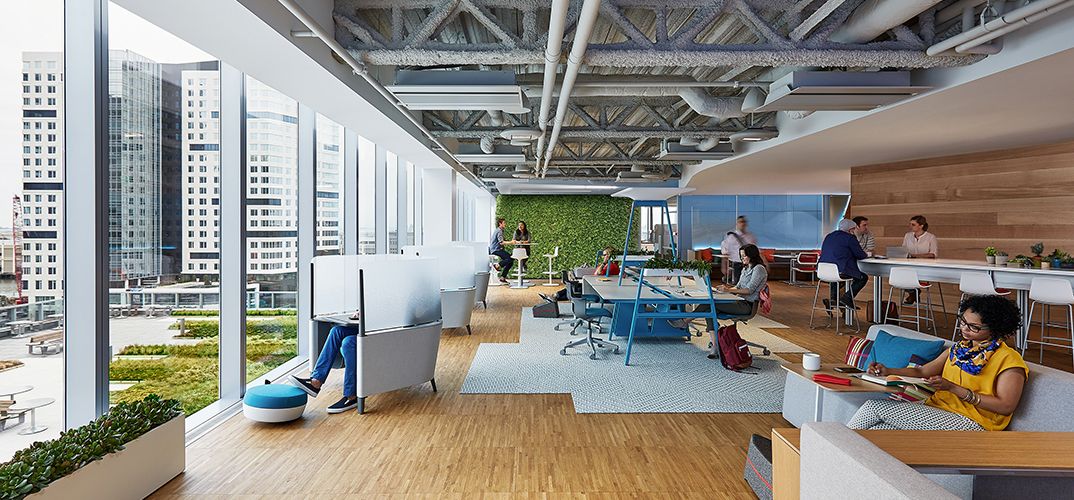Corporate office interior design plays a pivotal role in shaping the work environment, employee productivity, and the overall image of a company. Beyond aesthetics, a well-thought-out office design can significantly impact an organisation’s success.
In this comprehensive guide, we will dive into the key aspects of why corporate office interior design matters and how it can make a profound difference in your business. Let’s get started!
Reflects Company Culture
The design of your office is a tangible representation of your company’s culture, values, and brand identity. It sets the tone for how employees and visitors perceive your organisation.
A modern, vibrant, and well-designed office space can convey innovation and creativity, while a traditional, formal space may suggest stability and professionalism. It is a visual embodiment of what your company stands for.
Boosts Employee Productivity and Satisfaction
A well-designed office can directly impact employee productivity and job satisfaction. Thoughtful layouts, ergonomic furniture, natural lighting, and comfortable spaces for collaboration can lead to happier and more productive employees. When employees enjoy their workspace, they’re more likely to be engaged and motivated.
Consider the placement of workstations, the accessibility of tools and resources, and the ergonomics of the office furniture. The right design choices can lead to improved focus and efficiency.
Fosters Creativity and Collaboration
Fostering creativity and collaboration is a fundamental goal of contemporary office design. Open layouts, breakout areas, and technologically-equipped meeting spaces are carefully orchestrated to inspire teamwork and innovation.
Such design principles encourage employees to engage in spontaneous idea-sharing and collaborative problem-solving, nurturing a culture of creativity. These spaces break down physical barriers and hierarchical structures, promoting a sense of equality and shared purpose.
By creating an environment where employees can easily interact and brainstorm, businesses can tap into the collective knowledge and creativity of their workforce, resulting in more innovative solutions and a competitive edge in today’s dynamic and rapidly evolving business landscape.
Enhances the First Impression
Enhancing the first impression is a paramount objective of strategic office design. The office is often the initial point of contact for clients, partners, and potential employees, and it sets the tone for their perception of the organisation.
An aesthetically pleasing and well-designed office space creates an immediate positive impact, projecting professionalism and attention to detail. Elements such as the reception area, colour schemes, and the quality of furniture convey a sense of competence and reliability.
This strong first impression can instil confidence and trust, potentially leading to successful business relationships. It communicates that a company values its image and that it can be relied upon to deliver quality services or products.
Moreover, a welcoming and impressive office can attract top talent, as prospective employees are more likely to choose a company that appears well-organised and committed to creating an inspiring work environment.
Thus, enhancing the first impression through office design is a powerful tool for establishing credibility, forging partnerships, and attracting the best talent.
Improves Employee Wellbeing
Considerations for employee health and well-being are becoming increasingly important in office design. A well-designed office can include features such as indoor plants, comfortable seating, and clean air quality, all of which contribute to the physical and mental well-being of your staff.
When employees feel good in their workspace, they are more likely to stay healthy and engaged. Think about providing sit-stand desks, which can help employees combat the negative effects of prolonged sitting. Natural light and well-ventilated spaces can also have a positive impact on employee health.
Maximises Space Utilisation
Efficient space utilisation is essential for optimising operational costs. A well-planned office design can make the most of the available space, reducing unnecessary clutter and underutilised areas. This, in turn, can result in cost savings and improved workflow.
Consider flexible furniture and modular design that can adapt to the changing needs of your organisation. Utilise vertical space and ensure that areas like corridors and hallways are functional rather than wasted spaces.
Aligns with Modern Technology
In a tech-driven world, an office should be equipped with the latest technologies to support daily operations. A good design will accommodate modern infrastructure, including high-speed internet, video conferencing, and smart office solutions.
Ensure that your office is wired for the future. Consider technology integration that allows for seamless communication and collaboration. Up-to-date AV systems and easy access to charging ports can make your office more efficient.
Sustainability and Eco-Friendliness
Modern office design goes hand in hand with sustainability and eco-friendliness. Companies are increasingly looking for ways to reduce their environmental footprint, and the office space is a key area for making changes.
Consider using sustainable materials in your office design, such as recycled wood and energy-efficient lighting. Implement recycling and waste reduction programs, and aim for energy-efficient heating and cooling systems. Not only is this good for the environment, but it also aligns with the values of many employees and customers.
Employee Personalisation
Employee personalisation is an essential element of modern office design. It empowers employees to make their workspace their own, fostering a sense of ownership and belonging.
Personalisation can take the form of customised workstations with photos, artwork, or plants, allowing individuals to infuse their personality into their surroundings. This approach cultivates a more engaging and productive work environment by recognising the unique needs and preferences of each team member.
Ultimately, employee personalisation promotes a sense of identity, boosts morale, and leads to a more enjoyable and inspiring workplace, where employees are not just cogs in a machine but integral contributors to a vibrant corporate culture.
Reducing Noise and Distractions
An often underestimated aspect of office design is noise control. Open offices can be noisy, and distractions can reduce productivity.
Invest in acoustic panels, sound-absorbing materials, and well-planned layout designs that reduce noise and create quiet spaces for focused work. Quiet zones are essential for employees who require concentration.
The Role of Color Psychology
The colour scheme in your office design can significantly impact the mood and productivity of your employees. Different colours evoke different emotions.
Consider the use of warm colors in communal spaces to promote energy and creativity, and cooler tones in private spaces to encourage focus and calm. Colour choices should be aligned with the intended function of each area.
Flexibility and Adaptability
In today’s fast-paced business environment, flexibility is key. Your office design should be adaptable to changing needs and future growth.
Consider movable furniture, partition walls, and flexible workstations that can easily be reconfigured as your business evolves. The ability to adapt quickly can save time and resources.
Branding and Visual Identity
Branding and visual identity in office design are vital in conveying a company’s character. Beyond logos and signage, they define the overall look and feel of a space, making it unmistakably “you.”
By incorporating brand colours, symbols, and messaging into the design, your office becomes a visual representation of your organisation. This reinforces your identity, leaving a lasting impression on everyone who enters.
A well-executed visual identity connects employees and visitors to your brand’s essence, creating a cohesive and memorable experience that resonates with your values and image.
Employee Well-being Programs
Employee well-being programs in modern office design are pivotal for nurturing a healthy and balanced workplace. These programs include spaces for meditation, fitness, and relaxation, promoting the physical and mental health of employees.
With designated wellness areas, employees can find respite, recharge, and reduce stress. Such programs have the potential to enhance morale, reduce absenteeism, and increase overall job satisfaction.
By prioritising well-being, businesses create environments where employees are not only more productive but also happier, fostering a positive work culture. Employee well-being programs underscore a commitment to the holistic health of the workforce, resulting in a win-win for both employees and the organisation.
Conclusion
Corporate office interior design is more than just aesthetics, it’s a strategic tool for improving your organisation’s culture, productivity, and success. The way you design your office has a profound impact on employees, visitors, and your bottom line.
By investing in a thoughtful office design, you can create an environment that reflects your values, enhances employee well-being, and drives business growth. You can connect with the best office interior designers and they will help you build a workspace that attracts success!
In a rapidly evolving business landscape, where competition is fierce and talent is precious, your office design can be a significant differentiator. It can empower your employees to do their best work.
It enables you to welcome clients and partners into a space that reflects your professionalism and creates a work environment that’s conducive to innovation and success. Ultimately, corporate office interior design matters a lot because it shapes the way your organisation operates and thrives.





